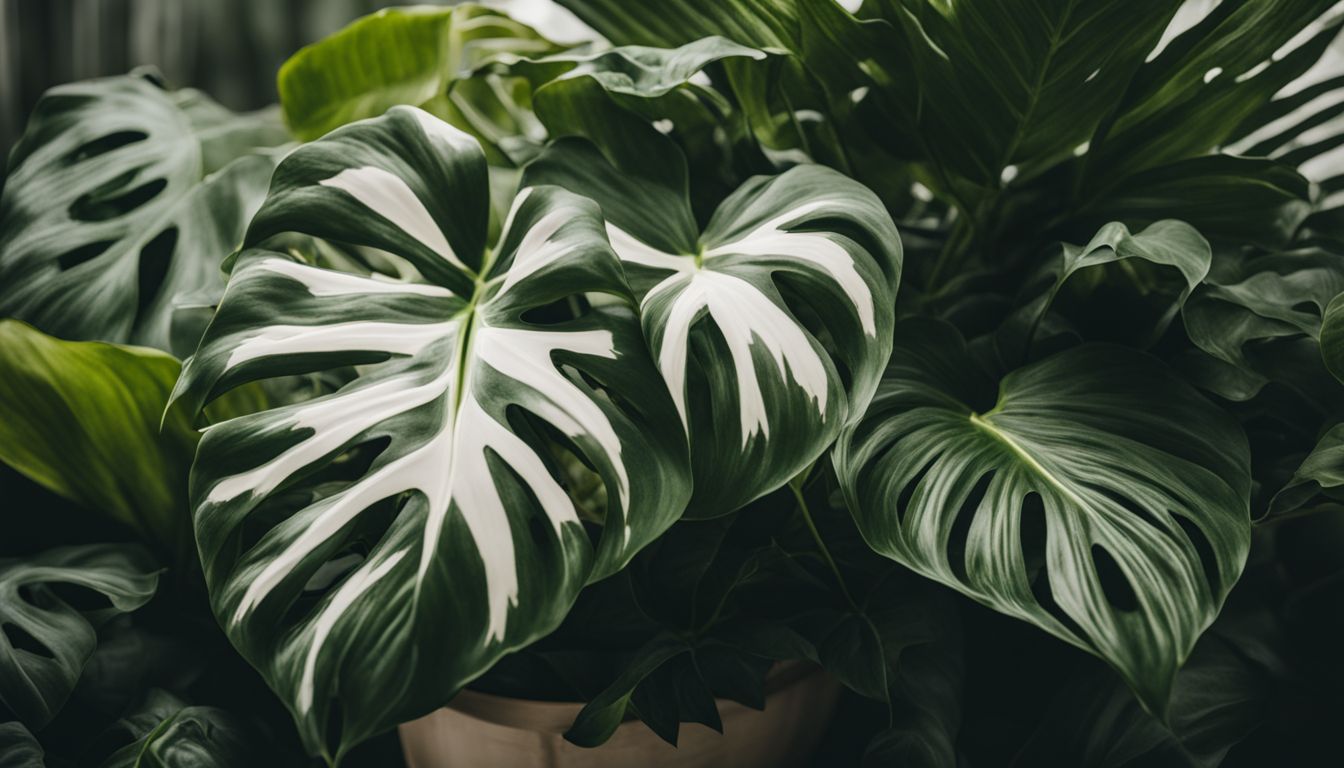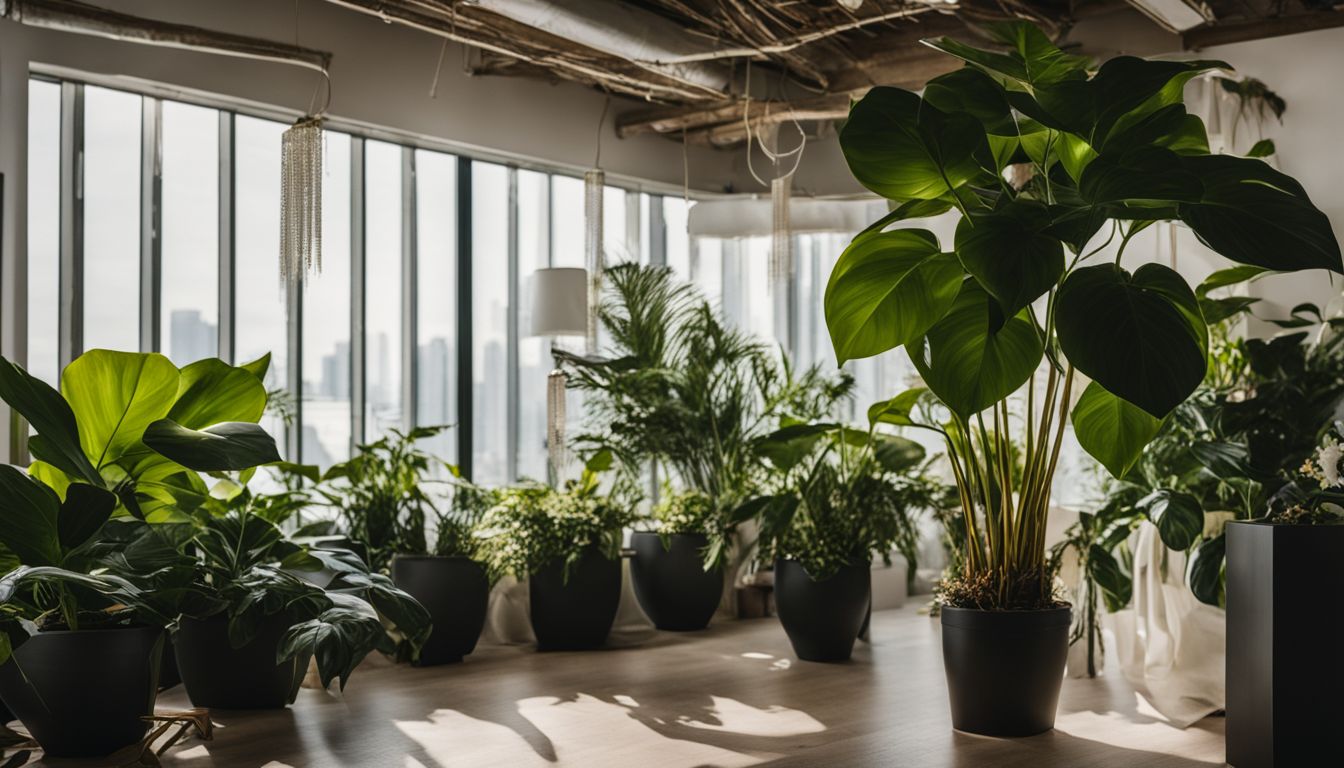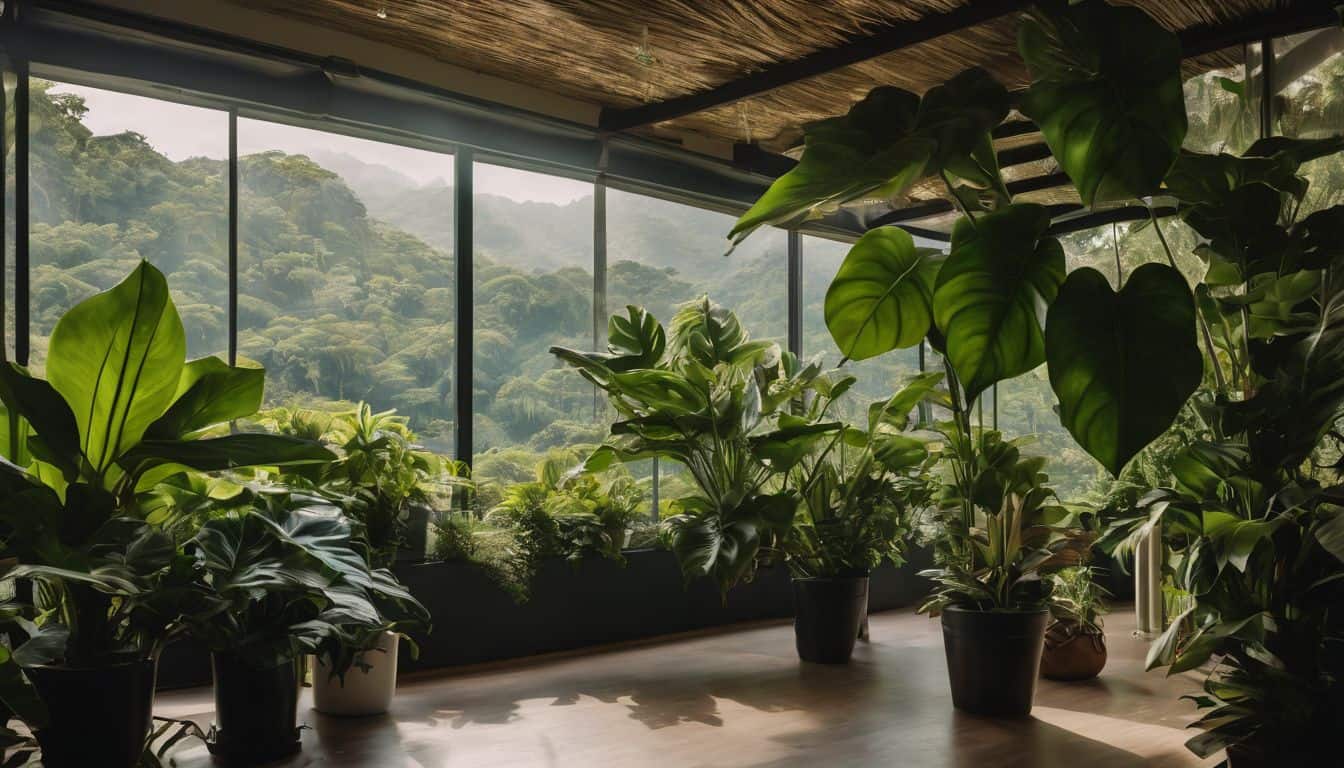Philodendron Birkin White Leaves – Philodendron Birkin is a beautiful houseplant with green and white striped leaves. Taking care of it the right way helps it stay healthy and look its best. White leaves on Philodendron Birkin can be tricky, but you can learn to keep them bright and lively.
Knowing why white leaves show up is important so you can tell normal new leaf colors from signs of trouble.
To stop white leaves from happening, make sure your plant gets up to 12 hours of light each day, but not direct sun that may burn the leaves. The soil should be just moist, with the top layer dry before adding more water.
This stops too much water which could harm roots and turn leaves white. Your Philodendron also likes damp air between 40-70%, like in a tropical place.
When feeding your plant in spring and summer months once a month will do! Make sure the soil drains well and isn’t too heavy or sandy – this makes a comfy home for your plant’s roots.
Watch out for tiny bugs that might want to eat your plant or make it sick; traps or gentle sprays like neem oil help keep them away.
If by chance some of those pesky white leaves appear, don’t fret! You might need to adjust how much water you’re giving or check if cool wet spots are making fungus grow on your beloved Birkin.
Like all plants, sometimes they outgrow their home so every three years give them fresh dirt in a slightly bigger pot. This keeps their growing spree going strong!
Now let me guide you through how we can prevent these problems together while keeping your Philodendron Birkin thriving at its best! Let’s dive into creating a happy environment for our leafy friends!
Key Takeaways
- Philodendron Birkin white leaves may happen if the plant doesn’t get enough light, is moved suddenly, or if overwatering causes root rot. Young leaves normally show more white but issues can arise if they turn all green or develop brown spots.
- To prevent white leaves, make sure your Philodendron Birkin gets bright, indirect sunlight and proper water with good drainage. Also use well-draining soil mix and fertilize once a month in the growing season.
- Fixing white leaves involves adjusting how much light the plant gets and making sure not to overwater it. Treat any fungal diseases with natural fungicide and manage pests like spider mites or aphids early on.
- Keep your Philodendron Birkin healthy by pruning yellow or damaged leaves. Use a humidifier to keep humidity around 60% ideal for growth. Repot every few years using fresh “Houseplant” compost in a pot just one size larger.
Understanding Philodendron Birkin White Leaves

When caring for your Philodendron Birkin, it’s important to recognize the potential issues that can lead to white leaves. Understanding the reasons behind this discoloration and differentiating between normal new growth and possible problems will help you maintain a healthy plant.
Reasons for White Leaves Appearance
Philodendron Birkin can sometimes have white leaves, and it’s important to know why. White leaves can happen when the plant doesn’t get enough light. All plants need light to make their food and stay healthy, and your Birkin is no different.
If your house plant spends too much time in the dark, new leaves might come out pale or completely white.
Another reason for white leaves could be a shock from being moved. Plants get used to where they live, so if you change their spot suddenly, they can react by growing white leaves.
It’s like how people need time to adjust when things change quickly.
The soil mix you use also matters a lot. Philodendron Birkin likes well-draining potting mix with peat moss or cocopeat because these help keep roots healthy by not letting them sit in water.
Overwatering leads to root rot, which is not good for your plant; this stress causes some of those pretty green leaves to turn white as well.
Normal New Growth vs. Potential Issues
I love watching my Philodendron Birkin grow. The new leaves unfurl with beautiful green and white pinstripes that make the plant so special. But sometimes, I notice changes that might mean there’s a problem.
It’s normal for young leaves to show more white when they first appear. They usually settle into their final pattern as they mature.
If all new leaves start turning completely green, this could be a sign of trouble. It may mean the plant is losing its unique white stripes due to a genetic mix-up.
Another issue can happen if the leaves turn yellow or develop brown spots; these can be signs that something isn’t quite right with how I’m caring for it, like too much sun or not enough water.
I keep an eye out for anything unusual in the pattern or color of the leaves because it helps me catch any issues early on. This way, I can adjust what I’m doing before major problems happen.
Keeping my birkin happy means giving it just what it needs: indirect sunlight, not overwatering, and making sure its pot has good drainage holes to prevent soggy soil.
Preventing White Leaves on Philodendron Birkin

To prevent white leaves on your Philodendron Birkin, it’s essential to ensure proper light exposure, correct watering techniques, ideal soil conditions, and adequate fertilization practices.
Without these key factors in place, the plant may experience stress and develop white leaves as a result.
Proper Light Exposure
I make sure my Philodendron Birkin gets just the right amount of light. It loves bright, indirect sunlight but direct sun is a big no-no. If it sits in too much direct sun, its leaves can get those ugly scorch marks.
I keep mine near a window where the sunshine is gentle but not shining straight on it. This helps maintain those pretty white parts on the leaves and keeps the plant happy.
For up to 12 hours each day, the plant needs this kind of soft light to look its best. I move it if there’s too much shade or if the sun starts peeking in directly. This balance stops leaves from turning yellow or brown and helps my Philodendron Birkin stay vibrant and healthy.
Next up, let’s talk about how water plays into keeping your birkin philodendron looking great!
Correct Watering Techniques
To keep your Philodendron Birkin healthy, watering it properly is crucial. Overwatering can lead to root rot, while underwatering can cause leaves to wilt. It’s essential to allow the soil to dry out between waterings.
When you water, make sure excess water can drain from the pot as stagnant water can harm the roots. Testing the moisture level by gently poking your finger into the soil about an inch deep will help determine when it’s time for watering again.
Remember that misting the leaves regularly and maintaining ideal humidity levels are also important aspects of watering and caring for your Philodendron Birkin. This plant thrives in slightly moist conditions but should not be constantly wet or dry.
Ideal Soil Conditions
To ensure optimal growth for your Philodendron Birkin, it’s crucial to provide the ideal soil conditions. This plant thrives in well-draining soil with good moisture retention. Aim for a pH balance of 6-7 and ensure proper aeration.
A mixture of potting soil and sphagnum moss can meet these requirements effectively. The addition of sphagnum moss aids in retaining moisture while promoting good drainage, creating the perfect environment for your Philodendron Birkin to flourish.
Furthermore, incorporating calcium-rich materials into the soil can benefit your plant’s health. Calcium is essential for cell wall structure and overall growth. Consider adding crushed eggshells or limestone to enhance the calcium content in the soil.
Adequate Fertilization Practices
Using a balanced liquid fertilizer once a month during the growing season can help maintain the health and vitality of your Philodendron Birkin plant. This practice contributes to preventing issues such as white leaves, ensuring that the leaves retain their characteristic creamy white color.
Along with proper light exposure, watering techniques, and soil conditions, adequate fertilization is crucial for the overall well-being of your plant. It’s essential to find the right balance in nutrient levels to support optimal growth and prevent potential problems from arising.
Remembering to adhere to monthly applications of a balanced liquid fertilizer will contribute significantly to maintaining your Philodendron Birkin’s health and vibrant appearance while preventing white leaves or other issues that may arise without adequate nourishment.
Fixing White Leaves on Philodendron Birkin
Adjusting sunlight exposure, balancing watering habits, treating fungal diseases, and managing pest infestations are crucial steps in fixing white leaves on your Philodendron Birkin.
For detailed instructions and practical examples, continue reading to ensure your plant’s optimal health and growth.
Adjusting Sunlight Exposure
To ensure healthy growth, I position my Philodendron Birkin in an area with bright, indirect light. Direct sunlight can cause its white leaves to turn brown. If the variegation on the leaves becomes excessive, it’s a sign that the plant may be getting too much light.
In this case, adjusting the sunlight exposure is crucial. I move my Philodendron Birkin to a spot with slightly lower light levels or add a sheer curtain for some protection from intense rays.
By doing so, I maintain the balance of light needed to keep those beautiful white leaves vibrant and healthy.
I make sure not to place my Philodendron Birkin in spaces without natural light or direct sunlight as this can result in yellowing and browning of its white leaves. Instead, I find spots where it receives sufficient but not harsh brightness for optimal growth.
Balancing Watering Habits
Now, let’s discuss the essential aspect of maintaining healthy Philodendron Birkin plants: balancing watering habits. It’s crucial to find the right balance with your watering routine to keep your plant thriving.
Overwatering can lead to root rot, which is a common issue for these plants. On the other hand, allowing the soil to dry out too much can cause stress and potential yellowing of leaves or brown patches on the variegation.
To ensure optimal conditions, check the moisture level in the soil before watering again. Insert your finger about an inch into the soil – if it feels dry at this depth, then it’s time to water your Philodendron Birkin.
Treating Fungal Diseases
To treat fungal diseases in Philodendron Birkin, it’s crucial to address the root cause. If you notice white spots or brown patches on the leaves, it may indicate a fungal infection resulting from overwatering or cool and wet conditions.
To combat this, ensure proper drainage for the plant and avoid leaving water sitting in the saucer. Additionally, consider treating with a natural fungicide like neem oil to help eliminate any existing fungal growth while preventing further spread.
Keeping the plant in an environment with optimal humidity levels can also discourage fungal development.
Managing Pest Infestations
Pest infestations like spider mites, scale, or aphids can make the leaves of your Philodendron Birkin turn yellow. It’s crucial to monitor your plant for webbing and waxy bumps as these are signs of infestation.
To combat this, traps, alcohol sprays, or neem oil can be used to manage pests effectively. Regularly checking humidity levels and overall plant health is key in preventing and addressing pest issues.
Now let’s move on to “Addressing Other Philodendron Birkin Issues” which includes dealing with brown spots on the leaves and other common problems faced by Philodendron Birkin plants.
Addressing Other Philodendron Birkin Issues
Dealing with Brown Spots on Philodendron Birkin can be a common concern for plant owners. Understanding the potential causes and implementing proper care techniques can help address this issue effectively.
Dealing with Brown Spots on Philodendron Birkin
Dealing with brown spots on Philodendron Birkin can be a concern for plant lovers like us. Here are some tips to help address and prevent this issue:
- Check the soil moisture regularly to ensure it’s not staying too wet or too dry, as both conditions can lead to brown spots on the leaves.
- Examine the watering habits and adjust them if necessary, making sure not to overwater, which can cause root rot and lead to brown spots.
- Inspect the plant for any signs of pest infestations such as spider mites or aphids, as they can cause damage that results in brown spots.
- Consider adjusting the amount of direct sunlight the plant receives, as excessive sun exposure can lead to leaf burn and browning.
- Ensure proper air circulation around the plant, as stagnant air can contribute to fungal issues that result in brown spots.
- Prune any affected leaves or areas with brown spots to prevent the spread of any potential diseases or issues.
- If there are concerns about soil quality, consider repotting the plant using well – draining soil mix tailored for philodendrons.
Additional Tips for Philodendron Birkin Health
– Pruning and Maintenance: Regularly trim off any yellow or damaged leaves, and repot the plant as needed to promote healthy growth.
– Repotting Guidelines: When repotting your Philodendron Birkin, ensure that the new pot has proper drainage and use a well-draining soil mix to prevent waterlogged roots.
– Ensuring Optimal Humidity Levels: Consider using a humidity tray, misting the leaves, or placing a small humidifier near your plant to maintain ideal moisture levels.
Pruning and Maintenance
Pruning and maintenance are vital to keep your Philodendron Birkin healthy. Regular pruning helps remove dead or yellowing leaves, promotes new growth, and maintains the plant’s shape.
Use clean, sharp scissors or pruning shears to trim any damaged or discolored leaves, making sure to cut at a 45-degree angle. Also, regularly wipe the leaves with a damp cloth to remove dust and keep them looking vibrant.
As for maintenance, periodically check for pests like spider mites or mealybugs which can harm your plant. Gently wiping the leaves with soapy water or using neem oil spray can help control these pests effectively.
Ensuring optimal humidity levels is also crucial for maintaining your Philodendron Birkin’s health and appearance. Consider placing a small humidifier near your plant or misting it occasionally to boost humidity levels.
Repotting Guidelines
To keep my Philodendron Birkin healthy and thriving, I make sure to repot it every three years. This helps to accommodate its rapid growth as it gets bigger. When I repot, I use fresh potting soil and choose a pot that’s just one size larger than the current one.
I opt for “Houseplant” compost and increase the pot size gradually.
Using a larger pot allows the roots to expand, aiding in the plant’s overall development. It’s essential not to rush this process by choosing a pot that is too large – gradual expansion nurtures healthier growth.
Ensuring Optimal Humidity Levels
To ensure optimal humidity levels for your Philodendron Birkin, it’s essential to maintain a consistent environment with a humidity range of 40-70%. Aim to keep the humidity at around 60% for the best growth of your plant.
You can easily achieve this by misting the leaves regularly or placing a humidifier near the plant. Another effective method is to use a pebble tray filled with water underneath the plant, providing an extra source of moisture.
In addition to these methods, consider using well-draining soil with added sphagnum moss or perlite, which helps retain moisture around the roots while also allowing excess water to drain away.
Conclusion
In conclusion, by understanding the causes and implementing the preventive measures for white leaves on Philodendron Birkin, you can maintain its health and vibrancy. The practical strategies provided are easy to follow and efficient in addressing potential issues.
Mastering these approaches can lead to a significant improvement in your plant’s condition, ensuring its long-term well-being. For further guidance, consider exploring additional resources or seeking professional advice if needed.
Remember, with the right care and attention, you can successfully prevent and fix white leaves on your Philodendron Birkin, fostering a thriving indoor plant environment for yourself.
FAQs
1. Why do my Philodendron Birkin leaves turn yellow?
Your Philodendron Birkin’s leaves might turn yellow if the plant doesn’t get enough light or water. Using a grow light and checking the soil can help.
2. How can I keep pests away from my indoor Philodendron Birkin?
To keep pests away, clean your plant’s leaves and use pest control methods safe for indoor plants.
3. What should I do if my Philodendron Birkin has white spots on its leaves?
If you see white spots, it could be calcium oxalate crystals which are natural for the plant. But if there are too many, check for pests or signs of disease.
4. Can spaghnum moss help my Philodendron Birkin stay healthy?
Yes! Spaghnum moss helps keep moisture around your plant’s roots which can prevent problems with the leaves and promote health.




